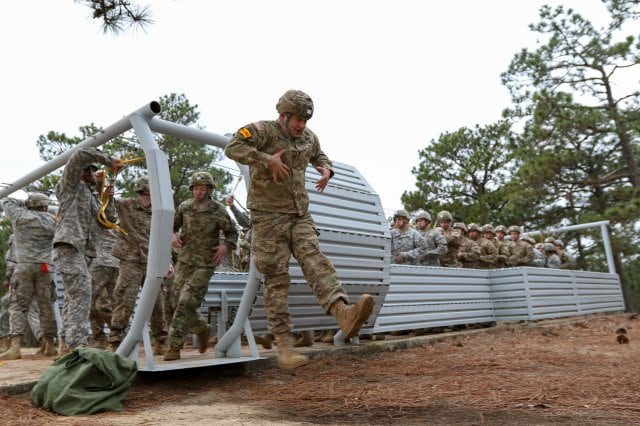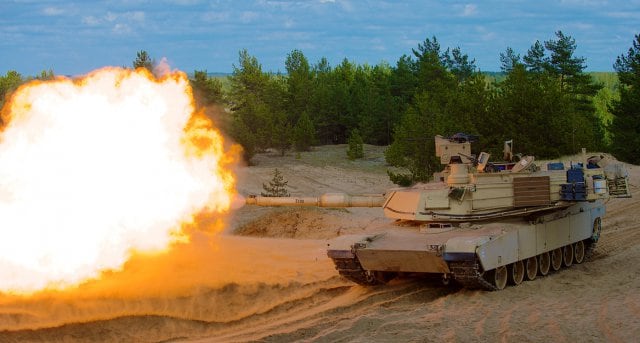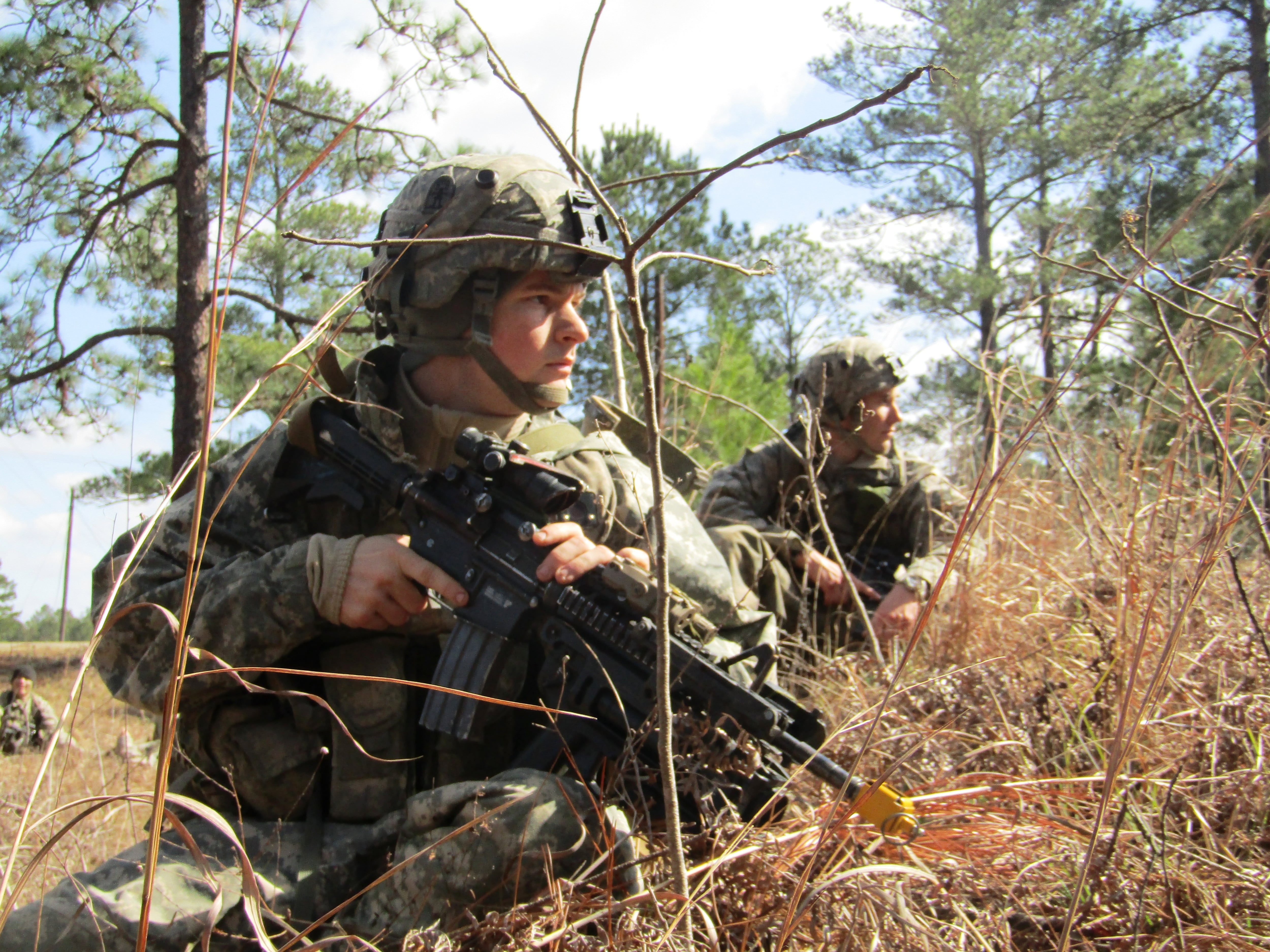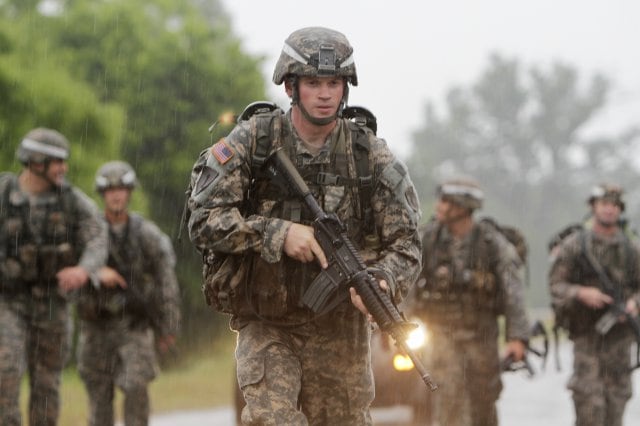Capt. Ronald Fletcher has met an officer candidate who couldn't find north on a compass, a sergeant who couldn't complete an inventory of equipment, and "far too many soldiers who couldn't fire a weapon straight, let alone understand how the weapon functions."
As a drill sergeant leader, Staff Sgt. Erick Avalos saw "a lot of senior NCOs, experienced noncommissioned officers lacking in the fundamentals" such as marching, drill and ceremony, and rifle marksmanship.
"These are basic things," he said. "Land navigation, for instance. These are senior NCOs, but they don't know it, they're not familiar with it. I feel that's something that's completely lost in the Army."
The problem is in the National Guard as well.
"If I took 10 E-4s and below and dropped them off in the middle of the woods with a map and compass, there's no way they're going to find their way out," said a staff sergeant medic who asked to remain anonymous. "Right now I have six soldiers come out of basic training, and four couldn't pass their PT test."
After more than 15 years of war — most of it in counter-insurgency operations — in Iraq and Afghanistan, the Army is returning its focus to the basics of soldiering, intent on building an Army ready to face a wide array of threats around the world.
This is critical as the Army gets smaller and budget cuts force the service to slow down its modernization priorities. And it is also critical as the Army works to rebuild a set of skills that have declined in the face of ever-improving technology and the Internet.
Today, more than 2,700 pieces of equipment in a brigade combat team run off GPS or satellite communications.
Cell phones work in Iraq and Afghanistan, and the Internet is a critical component to every tactical operations center across the Army.
But what happens if those systems fail? Or if the enemy launches an invasive and effective cyber or electronic warfare attack?
Could you find your way to your forward operating base with just a map and a compass? Could you communicate with your squad if your radios stop working? How about effectively and lethally running your weapon systems or combat vehicles?
"If you're asking if we've degraded our analog skills based upon technology and the increase of technology, of course we have," said Sergeant Major of the Army Dan Dailey. "And I agree we can't lose the ability to do those things analog-wise."
Any system is going to be targeted by your potential adversaries, Dailey said.
"When you design an electronic system, we're all fully aware they're subject to that," he said. "What do you fall back on? Systems that can't be messed with. It's pretty tough to mess with a map, a protractor, a pencil and a compass."

The Army is turning its focus back on basic soldier skills. Here, Staff Sgt. Marshall Wassel, right, of the Army National Guard Warrior Training Center, and Staff Sgt. Shane Johnson, of 2nd Brigade, 3rd Infantry Division, discuss Wassel's shots while bore sighting during the Marksmanship Master Trainer Course at Fort Benning, Ga.
Photo Credit: Brenda Rolin/Army
The Army "never lost sight" of those skills, Dailey said.
"What we did is we degraded the reinforcement of the leader development process with the use of technology, which is not bad, because they're accurate," he said. "When you use those things in a combat situation, they're making our organizations very lethal and very capable."
The use of electronic devices "isn't a failure," Dailey said.
"This is soldiers doing what's needed to accomplish the mission, and those tools have made them successful on the battlefield for the last 14 years," he said. "But based on our known threats, based on our assumed threats, we have to be prepared to revert back to our analog skills."
Soldiers also must be experts on their individual weapon systems, Dailey said.
"That's easily said, but it takes hours and hours and hours to do," he said. "It's not hard to do, but it takes time, it takes practice, it takes devotion. You have to continue to reinforce those things over and over again."
Many soldiers have lost their edge because they've been so busy with back-to-back deployments, said Avalos, who is now assigned to the Noncommissioned Officer Academy at Fort Hood, Texas. Before that, he served for a year a drill sergeant and a year as a drill sergeant leader at Fort Jackson, South Carolina.
"Our main focus has been fight, fight, fight, and we got away from the garrison environment where we conduct sergeant's time training," said Avalos, who has been in the Army for nine years and has deployed three times.
Problems in the ranks
Basic skills such as marching, drill and ceremony, and land navigation may seem to be low priorities, but they reinforce discipline across the board, Avalos said.
"Some might say, 'we don't do that in combat,' but to me it's discipline," he said.
Fletcher, a prior-service Marine who served as an active-duty Army officer for about eight years before transitioning to the Army Reserve, said he believes soldiers get more training on sexual assault prevention than in basic soldier skills.
For example, Fletcher said, one of his personnel clerks, after four years in the Army "didn't know that he was completing the standard forms all wrong. He was never properly trained because when he got to the unit it was work and mandatory training."
"We are so intently focused on mandatory training that we lose sight of the basics," said Fletcher, an explosive ordnance disposal officer with four deployments. "We focus on SHARP, which is extremely important, instead of teaching duty, honor and integrity from the moment these kids come into recruit training. We lose time in the training calendar to do MOS training because any white space fills with an ever increasing load of mandatory training."

Paratroopers from across Fort Bragg, N.C., practice aircraft exiting procedures at Sicily Drop Zone during the Saturday Proficiency Jump Program. The Army brought back the monthly jumps to build proficiency, experience and confidence of individual paratroopers. The program is just one of the ways the Army is refocusing its efforts on basic soldier skills.
Photo Credit: Staff Sgt. Jason Hull/Army
The Guard staff sergeant medic, who has served for 16 years, including in Afghanistan and Kosovo, said he once was on the range filling in as the medic on duty when he saw an infantry soldier who was having trouble shooting.
"Nobody was taking the time to help him out, so I did," the staff sergeant said. "He was an E-2 or E-3, and even if his leadership may not have been on the range, I feel somebody from his unit should be teaching him the fundamentals, or they didn't teach it enough [in basic training] for him to remember it."
The staff sergeant said his concern lies mostly with new soldiers, as he has worked with many mid-grade and senior soldiers who are proficient at their jobs.
"New privates come back from [advanced individual training] with very little discipline, no sense of a higher purpose, and very few can pass a PT test," he said. "Most of our training revolves around mandatory briefings, and very little time is actually spent training on basic soldier tasks."
The staff sergeant said he sees a lack in knowledge when it comes to map reading, land navigation, reacting to fire, first aid and marksmanship.
"There is only so much that you can cram into one weekend per month, and it seems to me that way too often training on basic tasks is just not important enough to happen," he said.
Response from leaders
Senior Army leaders are well aware of the need for the service to sharpen its basic skills — from the individual level all the way to brigade and beyond.
"The Army has the obligation to be ready to conduct sustained land operations across the spectrum of conflict and win in ground combat," Army Chief of Staff Gen. Mark Milley told the Senate Armed Services Committee during his confirmation hearing. "We cannot allow ourselves to focus too narrowly on one scenario."
The Army is "highly skilled" in counterterrorist and contingency operations along with advisory skills and building partner capacity, Milley said. But given emerging and future threats, the Army must not only sustain its skill set but rebuild "our combined arms conventional warfighter skills for offense, defense and stability."
Gen. Robert Abrams, the top general at Forces Command, also has called on soldiers to get back to the basics.
"We're very rusty as an Army in terms of our ability to execute the fundamentals of combined arms maneuver in that environment," he said.
To tackle the problem, the Army has put in place some major efforts.
This spring, the service rolled out Army-wide a new course at Fort Benning, Georgia, that focuses solely on the fundamentals of marksmanship, one of the core competencies for every soldier. The recently revamped Best Warrior Competition forces competitors to rely on what Dailey calls "analog skills," including land navigation with just a map and a compass.
The Army also is pushing its brigade combat teams to be proficient in combined arms maneuver, which includes training to face a combination of conventional forces, unconventional guerilla forces and an insurgency while dealing with cyber, electronic warfare, government officials and non-combatants.
"It reflects the world we live in today," Abrams said.
Much of this training takes place in the Decisive Action Training Environment, which tests leaders and soldiers in complex training scenarios.
"We're seeing signs of improvement in several different areas, but it's a combination of time available plus opportunities for repetitions at home station," Abrams said.

The Army is sharpening its basic skills and ability to conduct combined arms maneuver as it trains to face a wide array of threats. Here, an M1A2 Abrams tank from 2nd Battalion, 7th Infantry Regiment, 1st Armored Brigade Combat Team, 3rd Infantry Division fires its 102mm main gun during a gunnery table in Adazi, Latvia.
Photo Credit: Staff Sgt. Brooks Fletcher/Army
The ability to train those skills over and over again builds experience, competence and confidence, he said.
The Army has since, after a holistic review of its training, developed a list of 15 directed training events.
For example, directed training events for the Army's mechanized and armor infantry units include Bradley and tank gunnery tables. They also train to conduct company combined live-fire exercises, incorporating engineers, rotary-wing support and mortars.
"In one brigade combat team that recently finished a home station gunnery exercise, out of the 15 maneuver company commanders, only one of those captains had fired a gunnery on a combat platform," Abrams said. "There's a lack of experience across the force, and there's plenty of other examples across the pay grades."
Meanwhile, field artillery batteries are tasked with firing their own qualification tables and live-fire exercises.
"Three years ago, I don't think we had one artillery battalion fire Table 18," or a battalion live-fire qualification, Abrams said. "Last year, out of the 25 battalions in our brigade combat teams, we had, I think, 50 percent. This year we'll be much closer to 80 percent."
The Army's emphasis on restoring and mastering the fundamentals in combined arms maneuver is starting to pay off, Abrams said.
So far this fiscal year, which started Oct. 1, the Army has already used twice the amount of live ammunition it did this time last year, Abrams said.
"We're still under the maximum in according with our allocation, but that's a huge increase so far in FY16," he said. "We're starting to see opportunities for repetition and increased levels of readiness at the training centers. The only limiting factor now is when our units are deployed to missions downrange that are non-standard, for example to train, advise and assist."
Despite the progress it has made, the Army still has a long way to go, Abrams said.
"One repetition does not constitute mastery," he said. "We're not looking to achieve excellence, but be a master at it. That conveys the highest level of competency in those particular tasks. Everyone knows you don't create a master of anything in a short amount of time. It takes years."
The Army is serious about sharpening its fundamental skills at all levels, so much so that the service recently redesigned its Promotion Point Worksheet to reflect the importance of areas such as weapons qualification, physical fitness and leader development, Dailey said.
Beyond active-duty
The Army also is working to boost fundamental skills training in the Guard and Reserve, where it will take even more time.
"That's a real challenge," Abrams said, adding that the Army plans to add two more combat training center rotations for Guard BCTs starting in fiscal 2018, for a total of four a year.
"Our combat training centers are a crucible leadership opportunity," Abrams said. "So now we're going to increase the number of opportunities for our reserve component units to go through that crucible, which will enhance their leader development, it'll increase their efficiency and push us much, much closer toward mastering the fundamentals of warfighting at echelon."

U.S. Army Alaska's 4th Brigade Combat Team (Airborne), 25th Infantry Division, trained at the Joint Readiness Training Center, Fort Polk, La., earlier this year. The Army is putting its brigade combat teams through its combat training centers to sharpen their ability to conduct combined arms maneuver.
Photo Credit: Capt. Richard Packer/Army
The Army's goal is to achieve company-level proficiency in a Guard brigade combat team over the course of four years, he said.
"Because of the amount of training days in each of those four years, we're looking at proficiency — not mastery — at the company level," he said. "We'll do as best as we can at the battalion- and brigade-level tasks."
This is why Milley is pressing for more training days for certain reserve component units, Abrams said.
"It's to get us closer to mastery level and increase proficiency, but also with the express intent of when the call comes to reduce our post-mobilization time," he said. "The real end-state here is to decrease post-mobilization time when we need them."
The Army also has launched an Associated Units pilot program, which pairs active-duty units with those in the Army Reserve and Army National Guard so they can train together and even deploy together.
The program establishes formal relationships between the units, which will translate into more training days each year for the Guard and Reserve units involved. Among the first units paired together are Task Force 1-28 Infantry, an infantry battalion at Fort Benning, Georgia, and the Georgia National Guard's 48th Infantry Brigade Combat Team. The brigade also will be associated with the active Army's 3rd Infantry Division at Fort Stewart, Georgia.
"One of the aspects of the program is dedicated additional training days every year for those units, and then they'll go to the combat training centers," Abrams said. "Today, a Guard BCT goes to a combat training center once every eight years, 10 years. Those in the Associated Unit program are going to go either every other year or every third year. This is going to be a game-changer in terms of increased readiness for our reserve component."
As the program matures, the units will do more than just train together, Abrams said.
"The Associated Unit program is about being integrated," he said. "We're going to be doing everything together. We're going to exchange personnel, and we're going to give the gaining units authorities to provide leadership and command and control."

Soldiers trek 12 miles in the rain before taking their final test to earn the Expert Infantryman Badge.
Photo Credit: Marie Berberea/Army
A prior-service captain who serves as an observer/controller at the National Training Center at Fort Irwin, California, said he has seen soldiers struggle to use the equipment they have.
"I came in the military in 1993. I remember protractors and maps. I remember not having computers in the [tactical operations center] at all. There was no such thing," said the captain, who asked that his name be withheld. "I know near-peer militaries have the ability to do jamming of global positioning systems and all of that, which makes a lot of that equipment fancy paperweight. How quickly can a unit turn around and switch to manual systems?"
The captain said he has often wanted to see units be put through such a scenario, to "force the unit to make that transition, just to see how long it takes these brigades to shift," he said.
"I am old enough to remember the slide calculator days," he said. "Have we talked about when all these systems go down, can we continue to fight?"
Getting back on the trail
Master Sgt. Jean Dugrot, a civil affairs soldier stationed at Fort Bragg, North Carolina, said he thinks the Army has "fallen off the trail a little bit, and we need to get back into the basic soldiering skills."
"The problem we have is defining the basics. Is it gunnery for tankers, shooting for infantry, cooking for cooks? What are the basics?" he said.
In his mind, the basics encompass more than shooting, moving and communicating, said Dugrot, who has been in the Army about 15 years and has deployed six times.
"You could be taking care of the shooting, but if the soldier is not attending basic classes that would teach him how to shoot, and you're just sending him out to the range, how do we get soldiers to be proficient in the basics if they don't know exactly what the basics are?" he said.
In addition to basic soldier skills, soldiers also must take care of their personal lives, Dugrot said.
"The basics are taking care of everything that would get in the way of you conducting the mission in a proper way," he said. "If you don't take care of your family, which is a basic thing to do, how can you go downrange and be focused on the mission? If you don't take care of your health, and as a leader if you don't take care of yourself, how are you taking care of your soldiers?"
Michelle Tan is the editor of Army Times and Air Force Times. She has covered the military for Military Times since 2005, and has embedded with U.S. troops in Iraq, Afghanistan, Kuwait, Haiti, Gabon and the Horn of Africa.





